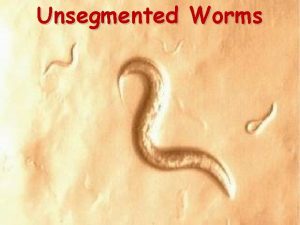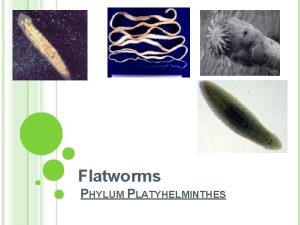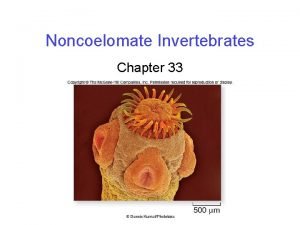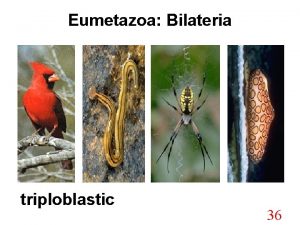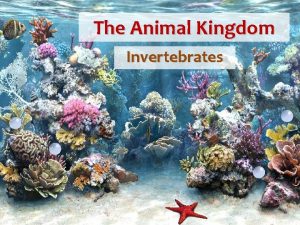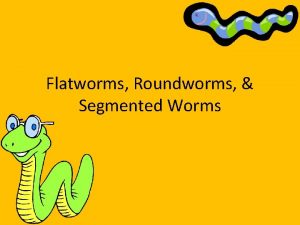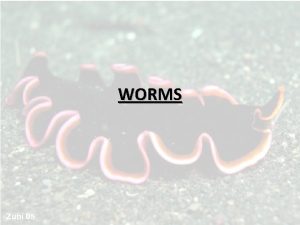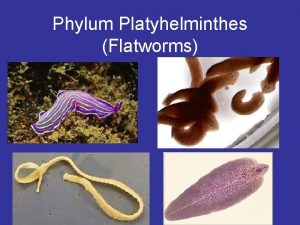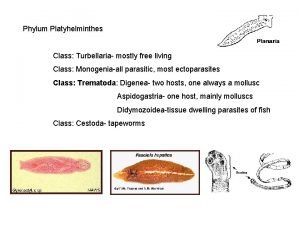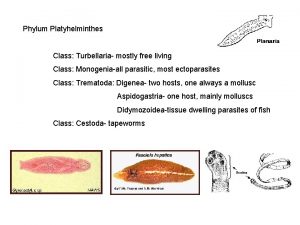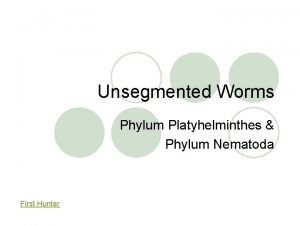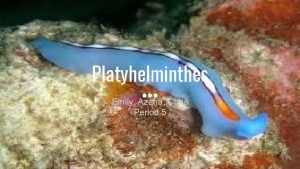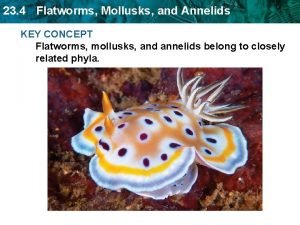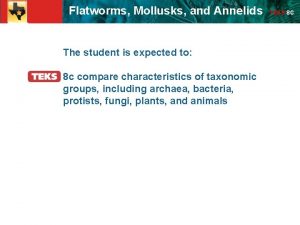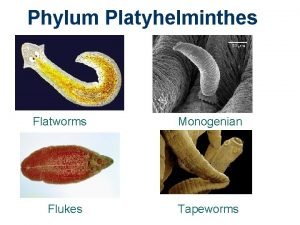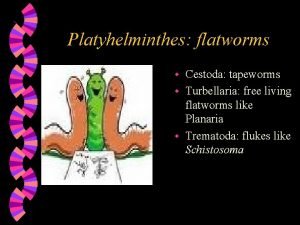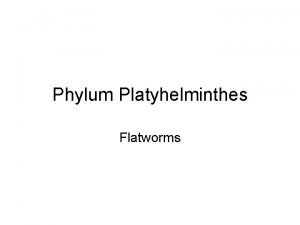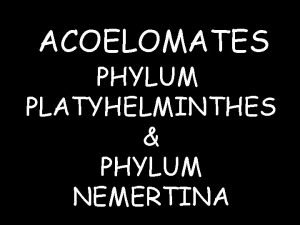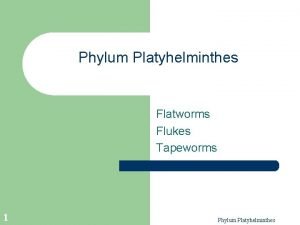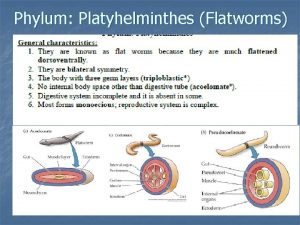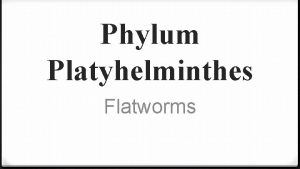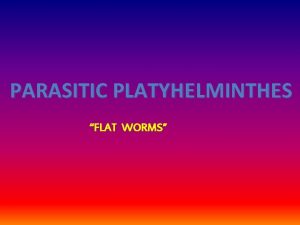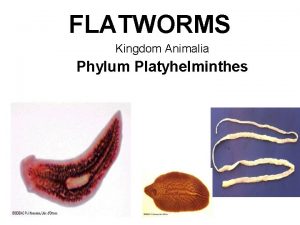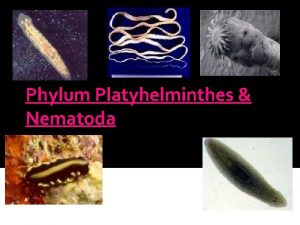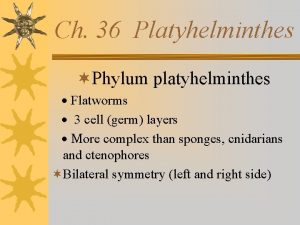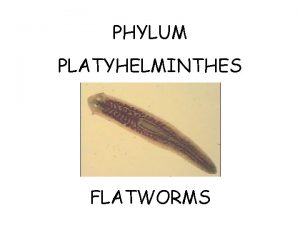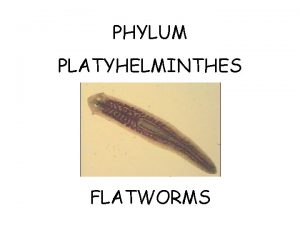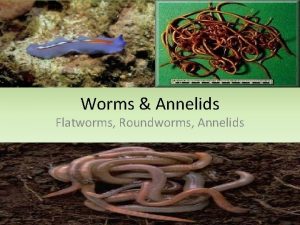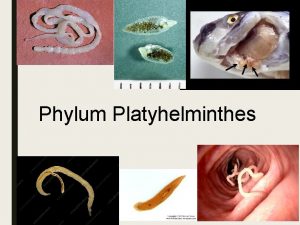PHYLUM PLATYHELMINTHES The Platyhelminthes or flatworms are the



















- Slides: 19


PHYLUM: PLATYHELMINTHES The Platyhelminthes or flat-worms are the lowest triploblastic animals and the first to develop distinct organs and systems.

General Characters of Platyhelminthes � Habitat: Most Platyhelminthes are parasites on other animals , only the Turbellarians are mostly free-living. � Body shape: Mostly worm like, generally dorsoventrally flattened and bilaterally symmetrical. � Structure: Body is triploblastic (having 3 layers of tissues) with organs and organelles and acoelomate (The space between the body wall and gut are filled with parenchyma composed of loose cell masses. ). � Digestive system: When present, it consists of a blind gut (i. e. it has a mouth but no anus), therefore the digestive waste products were excreted through the mouths.

General Characters of Platyhelminthes (Cont. ) � Respiratory and circulatory systems: They are absent. Respiration takes place by diffusion of the respiratory gases through the body surface into the surrounding medium. � Excretory system: Excretion is performed by specialized cells called flame cells. They lead into tubules which open out by one or more excretory pores. � Nervous system: Consisting of a pair of anterior ganglia with longitudinal nerve cords connected by transverse nerves. � Reproductive system: Both hermaphrodite and unisexual forms exist. � Classification: Platyhelminthes are classified into 3 classes; Turbellaria, Trematoda, and Cestoda.

Kingdom: Animalia Subkingdom: Metazoa Phylum: Platyhelminthes Class: Trematoda Order: Digenea Fasciola gigantica

Habitat They live in the bile ducts of cattle and other mammals (primary or final host), feeding on the bile and causing the disease known as “liver rot” or fasciolosis as a result of the irritation caused by their surface spines; such irritation is sometimes fatal. The common species in Egypt and Africa in general is Fasciola gigantica, which infects cattle, sheep and goats. Another species is F. hepatica, which is more common in Europe and Australia. Species of freshwater snails are the intermediate hosts (e. g. Galba truncatula for F. hepatica and Limnaea cailliaudi for F. gigantica).

Morphology

Digestive system and nutrition

Excretory and nervous systems

Reproductive systemn

Life cycle

Limnaea shell Cercaria of Fasciola

Kingdom: Animalia Subkingdom: Metazoa Phylum: Platyhelminthes Class: Trematoda Order: Digenea e. g. : Schistosoma

Digestive system and nutrition The alimentary canal � starts with a small buccal cavity which leads into a thin oesophagus surrounded by an oesophageal gland. The oesophagus leads to the intestine which divides in front of the ventral sucker into two intestinal caeca, but these reunite to form a single sinuous common caecum.

Respiration, Excretory, Nervous and Muscular Systems Excretory, nervous and muscular systems: These systems are similar to those of Fasciola. � Respiration: Like the liver flukes, schistosomes have no specialized system for respiration. Although they live in the blood where the oxygen tension is relatively high, respiration appears to be largely anaerobic � �

Reproductive system

Life cycle

Bulinus shell Biomphalaria shell Schistosoma cercarea

 Insidan region jh
Insidan region jh Unsegmented worms phylum
Unsegmented worms phylum Phylum
Phylum Asexual reproduction of flatworm
Asexual reproduction of flatworm Invertebrate phylogeny
Invertebrate phylogeny Are nemertea triploblastic
Are nemertea triploblastic Phylum platyhelminthes characteristics
Phylum platyhelminthes characteristics Flatworm and roundworm difference
Flatworm and roundworm difference Characteristics of platyhelminthes
Characteristics of platyhelminthes Plat worm
Plat worm Ventral sucker
Ventral sucker Tapeworm class
Tapeworm class Monogenia
Monogenia Genital atrium
Genital atrium Small flat unsegmented worms
Small flat unsegmented worms Platyhelminthes
Platyhelminthes Section 4 flatworms mollusks and annelids
Section 4 flatworms mollusks and annelids Section 4 flatworms mollusks and annelids
Section 4 flatworms mollusks and annelids Phylum and class
Phylum and class Free living flatworms
Free living flatworms

